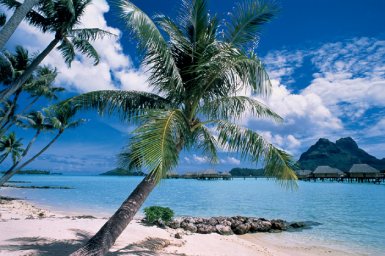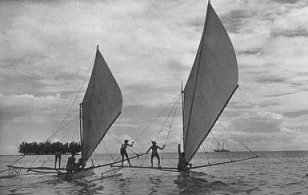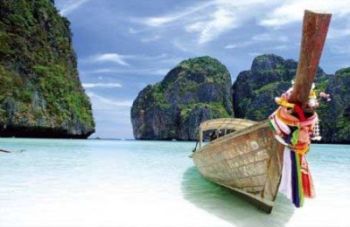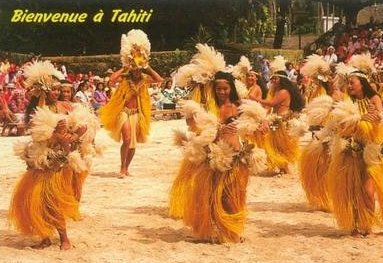People come to French Polynesia to live it up in stylish resorts, scuba dive in lagoons teeming with tropical fish, gorge on the unique mix of French and Polynesian cuisine and, basically, experience a little French chic mixed with South Pacific charm.
For more than 200 years, Tahiti has represented the tropical-paradise myth for Europeans. It's French Polynesia's biggest, most famous and historically interesting island, but the glossy pictures that you see in travel agents' windows are almost certainly some other French Polynesian island.
When to Go
The month-long Heiva i Tahiti festivities in July are to Tahiti what Carnaval is to Brazil and people come in droves to be part of them. The festival occurs in the drier and cooler June-through-October period which is, perhaps, the best time to visit the territory. Visitors during this period should, however, take into account the maraamu tradewinds which can bring unstable weather from the south between June and August. The weather gets warmer and more humid between November and the end of May. The Northern Hemisphere holiday periods - Christmas to the beginning of January, late February/early March, Easter, early May and the long northern-summer holiday in July-August - are busy times and flights can be hard to get.
Sightseeing

Divers come from all over the world to Rangiroa and the configuration of the lagoon is such that the rise and fall of the tide causes powerful currents that divers 'surf'. There's a great abundance and diversity of marine life within the lagoon. Pearl farming and mother-of-pearl production are important to the local economy.
Due south of the Societies, and strung along the Tropic of Capricorn, are the Austral islands. The Australs are famous for their arts - elaborate woodcarvings and enormous stone tiki - although the missionaries succeeded in destroying the ancient techniques and today there are almost no traditional artisans. The Australs are quite varied (although they have none of the fecund vegetation of the Societies to the north) and feature limestone caverns, ruined temples (maraes) and hilltop fortresses (pa) on the territory's southernmost island, Rapa.
History
Just how the Polynesian peoples came to populate their islands of the Pacific is a subject of some debate. What is clear, however, is that they were great sailors and navigators who traversed vast distances of open ocean to settle as far and wide as present-day French Polynesia, Hawaii, New Zealand, parts of the New Guinea island, Tonga and the Cook Islands. It's thought that they left South-East Asia around 3000 or 4000 years ago and began to arrive in present-day French Polynesia around 300 AD. Islands were originally ruled by chieftains who commanded huge fleets of outrigger canoes; religious practices at this time included human sacrifices.
Some of the first European visitors, among them Samuel Wallis (1767), Louis-Antoine de Bougainville (1768) and James Cook (1769), returned with stories of a paradise on earth inhabited by 'noble savages' and Venus-like women whose sexual favours were freely offered to the visitors. Europe was abuzz with stories of a tropical haven of free love when Bougainville returned to Paris and this myth attracted the likes of Herman Melville, Robert Louis Stevenson and Paul Gauguin.
The most famous event in the region's recent history was the mutiny on the Bounty. It was on Tahiti and the Austral island of Tubuai that Fletcher Christian and his mutineers sought refuge after setting William Bligh and his faithful crew members adrift in a tiny open boat near the Tongan islands on 28 April 1789. And, ultimately, it was on Tahiti that the long arm of British law rounded up those mutineers who hadn't escaped to Pitcairn Island, and made them face British justice.
At the time of the mutiny,

the Polynesian islands were ruled locally by important families - there was no all-prevailing ruler. The Polynesians had long realised the power of European weaponry and had courted earlier visitors to make allegiances in regional power struggles. While Cook, Bougainville and others had resisted this, the Bounty mutineers offered themselves as mercenaries. The Pomares, just one of the powerful Tahitian families, secured their services and, as a consequence, came to control most of the islands.
Soon whalers and traders were calling in at the Polynesian islands, trading weapons for fresh food, introducing the notion of prostitution and spreading European diseases to which the islanders had no natural immunity. Protestant missionaries were deployed to put an end to all that nudity, erotic dancing, wanton sex and heathen religion, and traditional Polynesian culture rapidly fell apart. The islands' population plummeted and the tyrannical Protestant missionaries razed Polynesian temples (marae) to the ground, forbidding any activities that were not devoutly Christian.
And then the French came. They were already in control of the Marquesian archipelago to the northeast and after much filibustering, political browbeating and intimidation, managed to oust the English and secure most of what would become French Polynesia in 1842. Queen Pomare IV, who had already done much to unify the islands under her rule, was forced to yield to the French and spent the rest of her 50-year reign as a figurehead.
At the turn of the 20th century the Polynesian islands became part of the Établissements français d'Océanie (French Pacific Settlements) and a programme of rapid commercial expansion was introduced. Chinese labourers came to work on vanilla and cotton plantations, and copra and mother-of-pearl production became the cornerstone of the French Polynesian economy. Nearly 1000 Polynesians were sent to Europe to fight the Germans in WWI, and 5000 US soldiers landed on Bora Bora soon after the USA's entrance into WWII to thwart the Japanese advance in the Pacific.
The French had been testing weapons in the Sahara Desert, but Algerian independence caused General de Gaulle to announce in 1963 that the tiny atolls of Moruroa (often misspelt 'Mururoa') and Fangataufa in the Tuamotus would serve as the new sites for weapons testing, and the Centre d'expérimentations du Pacifique was born. As a result of continuing world opposition, the testing shifted underground in 1981. Of course the French claim that the testing is perfectly safe but don't seem prepared to conduct it on French domestic soil.
In 1995 when French president Jacques Chirac announced that a new series of underground tests were to be conducted, the world reverberated with protest and condemnation.

Riots in the streets of Pape'ete saw hundreds of cars overturned and buildings set alight, and the Chilean and New Zealand ambassadors were recalled from Paris. The tests were completed in early 1996 and the French government has since stated that the nuclear-testing programme is over. After more than 150 separate tests of up to 200 kilotons (10 times more powerful than the bomb which levelled Hiroshima) the dust has once again settled around the atolls of Moruroa and Fangataufa, though the longer-term effects remains to be seen.
There is now a considerable groundswell of calls for independence from France, but the orthodox political powers, headed by President Gaston Flosse, have made it clear this will not happen - at least not in the medium term - and France seems unlikely to relinquish its overseas territories. French Polynesia currently has a 41-member Territorial Assembly elected by popular vote every five years. The Republic of France is represented in the territory by a high commissioner appointed by the Republic. Over a 20 year period, ending in 1996, the island group took over internal management, but calls for independence are a permanent fixture on the political map.
Culture
The missionaries did all they could to wipe out traditional Polynesian culture by levelling temples, destroying carvings, and banning tattoos and that heady,

erotic dancing that Bougainville told Europe about. The missionaries sought to make the Polynesians follow the teachings of the Good Book and their own autocratic commandments, but fortunately some of the traditional ways survived. Recently there's been a strong push to revive old ways and rediscover traditional arts. Traditional musical instruments include pahu and toere drums and the curious nose flute called a vivo. Guitars and ukuleles made their way into Polynesia and the locals developed a unique song style that owes much to country & western music in form but has a distinctive South Pacific island groove. Customary dancing (tamure) has slowly made its way back into French Polynesian life, but, sadly, the art of making tapa (bark paper and cloth), practised throughout the Pacific, has all but disappeared.
Things are pretty laid back in French Polynesia - dress standards are relaxed even in the classiest restaurants and beach wear is often just from the waist down. Church is deadly serious though and Sunday is the day of worship (fully clothed). The Polynesian concept of family is a much broader one than in the West - cousins, uncles, aunts etc are all part of the scene and are called fetii. The family might also have adopted children, faaamu, and children are commonly entrusted to relatives or childless women.
French Polynesia has a unique culinary tradition, with old South Pacific cooking methods combining with French gastronomy and Italian and Chinese influences. This manifests itself not just in the flashy restaurants but also in the cheap roadside mobile snack bars, les roulottes. Food is still cooked in traditional pit ovens that are common throughout the Pacific. A hole is dug in the ground, stones are placed within it and then a fire is lit to heat the stones. The food, wrapped in banana leaves, is placed on top, and then the hole is filled in again with earth. The baking process takes several hours. In French Polynesia this kind of oven is called an ahimaa and the feast is called a tamaaraa.



 the Polynesian islands were ruled locally by important families - there was no all-prevailing ruler. The Polynesians had long realised the power of European weaponry and had courted earlier visitors to make allegiances in regional power struggles. While Cook, Bougainville and others had resisted this, the Bounty mutineers offered themselves as mercenaries. The Pomares, just one of the powerful Tahitian families, secured their services and, as a consequence, came to control most of the islands.
Soon whalers and traders were calling in at the Polynesian islands, trading weapons for fresh food, introducing the notion of prostitution and spreading European diseases to which the islanders had no natural immunity. Protestant missionaries were deployed to put an end to all that nudity, erotic dancing, wanton sex and heathen religion, and traditional Polynesian culture rapidly fell apart. The islands' population plummeted and the tyrannical Protestant missionaries razed Polynesian temples (marae) to the ground, forbidding any activities that were not devoutly Christian.
And then the French came. They were already in control of the Marquesian archipelago to the northeast and after much filibustering, political browbeating and intimidation, managed to oust the English and secure most of what would become French Polynesia in 1842. Queen Pomare IV, who had already done much to unify the islands under her rule, was forced to yield to the French and spent the rest of her 50-year reign as a figurehead.
At the turn of the 20th century the Polynesian islands became part of the Établissements français d'Océanie (French Pacific Settlements) and a programme of rapid commercial expansion was introduced. Chinese labourers came to work on vanilla and cotton plantations, and copra and mother-of-pearl production became the cornerstone of the French Polynesian economy. Nearly 1000 Polynesians were sent to Europe to fight the Germans in WWI, and 5000 US soldiers landed on Bora Bora soon after the USA's entrance into WWII to thwart the Japanese advance in the Pacific.
The French had been testing weapons in the Sahara Desert, but Algerian independence caused General de Gaulle to announce in 1963 that the tiny atolls of Moruroa (often misspelt 'Mururoa') and Fangataufa in the Tuamotus would serve as the new sites for weapons testing, and the Centre d'expérimentations du Pacifique was born. As a result of continuing world opposition, the testing shifted underground in 1981. Of course the French claim that the testing is perfectly safe but don't seem prepared to conduct it on French domestic soil.
In 1995 when French president Jacques Chirac announced that a new series of underground tests were to be conducted, the world reverberated with protest and condemnation.
the Polynesian islands were ruled locally by important families - there was no all-prevailing ruler. The Polynesians had long realised the power of European weaponry and had courted earlier visitors to make allegiances in regional power struggles. While Cook, Bougainville and others had resisted this, the Bounty mutineers offered themselves as mercenaries. The Pomares, just one of the powerful Tahitian families, secured their services and, as a consequence, came to control most of the islands.
Soon whalers and traders were calling in at the Polynesian islands, trading weapons for fresh food, introducing the notion of prostitution and spreading European diseases to which the islanders had no natural immunity. Protestant missionaries were deployed to put an end to all that nudity, erotic dancing, wanton sex and heathen religion, and traditional Polynesian culture rapidly fell apart. The islands' population plummeted and the tyrannical Protestant missionaries razed Polynesian temples (marae) to the ground, forbidding any activities that were not devoutly Christian.
And then the French came. They were already in control of the Marquesian archipelago to the northeast and after much filibustering, political browbeating and intimidation, managed to oust the English and secure most of what would become French Polynesia in 1842. Queen Pomare IV, who had already done much to unify the islands under her rule, was forced to yield to the French and spent the rest of her 50-year reign as a figurehead.
At the turn of the 20th century the Polynesian islands became part of the Établissements français d'Océanie (French Pacific Settlements) and a programme of rapid commercial expansion was introduced. Chinese labourers came to work on vanilla and cotton plantations, and copra and mother-of-pearl production became the cornerstone of the French Polynesian economy. Nearly 1000 Polynesians were sent to Europe to fight the Germans in WWI, and 5000 US soldiers landed on Bora Bora soon after the USA's entrance into WWII to thwart the Japanese advance in the Pacific.
The French had been testing weapons in the Sahara Desert, but Algerian independence caused General de Gaulle to announce in 1963 that the tiny atolls of Moruroa (often misspelt 'Mururoa') and Fangataufa in the Tuamotus would serve as the new sites for weapons testing, and the Centre d'expérimentations du Pacifique was born. As a result of continuing world opposition, the testing shifted underground in 1981. Of course the French claim that the testing is perfectly safe but don't seem prepared to conduct it on French domestic soil.
In 1995 when French president Jacques Chirac announced that a new series of underground tests were to be conducted, the world reverberated with protest and condemnation.
 Riots in the streets of Pape'ete saw hundreds of cars overturned and buildings set alight, and the Chilean and New Zealand ambassadors were recalled from Paris. The tests were completed in early 1996 and the French government has since stated that the nuclear-testing programme is over. After more than 150 separate tests of up to 200 kilotons (10 times more powerful than the bomb which levelled Hiroshima) the dust has once again settled around the atolls of Moruroa and Fangataufa, though the longer-term effects remains to be seen.
There is now a considerable groundswell of calls for independence from France, but the orthodox political powers, headed by President Gaston Flosse, have made it clear this will not happen - at least not in the medium term - and France seems unlikely to relinquish its overseas territories. French Polynesia currently has a 41-member Territorial Assembly elected by popular vote every five years. The Republic of France is represented in the territory by a high commissioner appointed by the Republic. Over a 20 year period, ending in 1996, the island group took over internal management, but calls for independence are a permanent fixture on the political map.
Riots in the streets of Pape'ete saw hundreds of cars overturned and buildings set alight, and the Chilean and New Zealand ambassadors were recalled from Paris. The tests were completed in early 1996 and the French government has since stated that the nuclear-testing programme is over. After more than 150 separate tests of up to 200 kilotons (10 times more powerful than the bomb which levelled Hiroshima) the dust has once again settled around the atolls of Moruroa and Fangataufa, though the longer-term effects remains to be seen.
There is now a considerable groundswell of calls for independence from France, but the orthodox political powers, headed by President Gaston Flosse, have made it clear this will not happen - at least not in the medium term - and France seems unlikely to relinquish its overseas territories. French Polynesia currently has a 41-member Territorial Assembly elected by popular vote every five years. The Republic of France is represented in the territory by a high commissioner appointed by the Republic. Over a 20 year period, ending in 1996, the island group took over internal management, but calls for independence are a permanent fixture on the political map.
 erotic dancing that Bougainville told Europe about. The missionaries sought to make the Polynesians follow the teachings of the Good Book and their own autocratic commandments, but fortunately some of the traditional ways survived. Recently there's been a strong push to revive old ways and rediscover traditional arts. Traditional musical instruments include pahu and toere drums and the curious nose flute called a vivo. Guitars and ukuleles made their way into Polynesia and the locals developed a unique song style that owes much to country & western music in form but has a distinctive South Pacific island groove. Customary dancing (tamure) has slowly made its way back into French Polynesian life, but, sadly, the art of making tapa (bark paper and cloth), practised throughout the Pacific, has all but disappeared.
Things are pretty laid back in French Polynesia - dress standards are relaxed even in the classiest restaurants and beach wear is often just from the waist down. Church is deadly serious though and Sunday is the day of worship (fully clothed). The Polynesian concept of family is a much broader one than in the West - cousins, uncles, aunts etc are all part of the scene and are called fetii. The family might also have adopted children, faaamu, and children are commonly entrusted to relatives or childless women.
French Polynesia has a unique culinary tradition, with old South Pacific cooking methods combining with French gastronomy and Italian and Chinese influences. This manifests itself not just in the flashy restaurants but also in the cheap roadside mobile snack bars, les roulottes. Food is still cooked in traditional pit ovens that are common throughout the Pacific. A hole is dug in the ground, stones are placed within it and then a fire is lit to heat the stones. The food, wrapped in banana leaves, is placed on top, and then the hole is filled in again with earth. The baking process takes several hours. In French Polynesia this kind of oven is called an ahimaa and the feast is called a tamaaraa.
erotic dancing that Bougainville told Europe about. The missionaries sought to make the Polynesians follow the teachings of the Good Book and their own autocratic commandments, but fortunately some of the traditional ways survived. Recently there's been a strong push to revive old ways and rediscover traditional arts. Traditional musical instruments include pahu and toere drums and the curious nose flute called a vivo. Guitars and ukuleles made their way into Polynesia and the locals developed a unique song style that owes much to country & western music in form but has a distinctive South Pacific island groove. Customary dancing (tamure) has slowly made its way back into French Polynesian life, but, sadly, the art of making tapa (bark paper and cloth), practised throughout the Pacific, has all but disappeared.
Things are pretty laid back in French Polynesia - dress standards are relaxed even in the classiest restaurants and beach wear is often just from the waist down. Church is deadly serious though and Sunday is the day of worship (fully clothed). The Polynesian concept of family is a much broader one than in the West - cousins, uncles, aunts etc are all part of the scene and are called fetii. The family might also have adopted children, faaamu, and children are commonly entrusted to relatives or childless women.
French Polynesia has a unique culinary tradition, with old South Pacific cooking methods combining with French gastronomy and Italian and Chinese influences. This manifests itself not just in the flashy restaurants but also in the cheap roadside mobile snack bars, les roulottes. Food is still cooked in traditional pit ovens that are common throughout the Pacific. A hole is dug in the ground, stones are placed within it and then a fire is lit to heat the stones. The food, wrapped in banana leaves, is placed on top, and then the hole is filled in again with earth. The baking process takes several hours. In French Polynesia this kind of oven is called an ahimaa and the feast is called a tamaaraa.